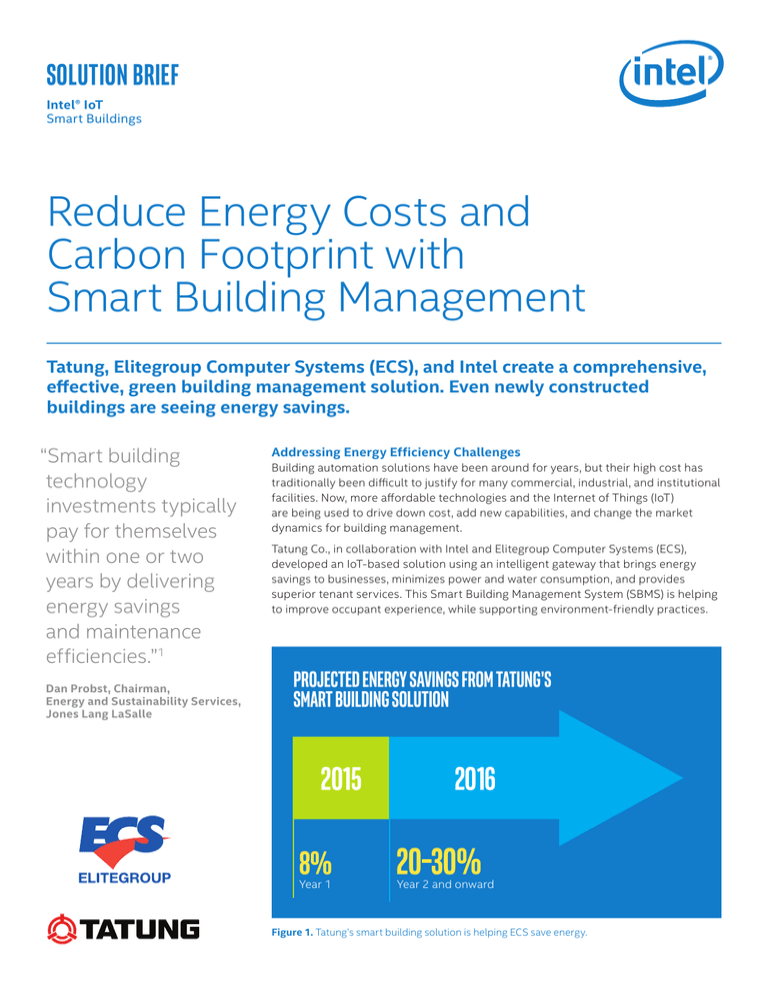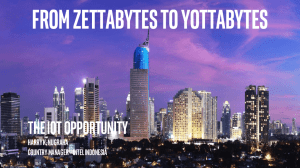
SOLUTION brief
Intel® IoT
Smart Buildings
Reduce Energy Costs and
Carbon Footprint with
Smart Building Management
Tatung, Elitegroup Computer Systems (ECS), and Intel create a comprehensive,
effective, green building management solution. Even newly constructed
buildings are seeing energy savings.
“Smart building
technology
investments typically
pay for themselves
within one or two
years by delivering
energy savings
and maintenance
efficiencies.”1
Dan Probst, Chairman,
Energy and Sustainability Services,
Jones Lang LaSalle
Addressing Energy Efficiency Challenges
Building automation solutions have been around for years, but their high cost has
traditionally been difficult to justify for many commercial, industrial, and institutional
facilities. Now, more affordable technologies and the Internet of Things (IoT)
are being used to drive down cost, add new capabilities, and change the market
dynamics for building management.
Tatung Co., in collaboration with Intel and Elitegroup Computer Systems (ECS),
developed an IoT-based solution using an intelligent gateway that brings energy
savings to businesses, minimizes power and water consumption, and provides
superior tenant services. This Smart Building Management System (SBMS) is helping
to improve occupant experience, while supporting environment-friendly practices.
Projected Energy Savings from Tatung’s
Smart Building Solution
2015
8%
Year 1
2016
20–30%
Year 2 and onward
Figure 1. Tatung’s smart building solution is helping ECS save energy.
Intel® IoT Smart Buildings
Concern for the Environment Drives Improvements
in Building Efficiencies
Reducing energy consumption is good for both the bottom line
and the environment. It can also be essential for compliance
with government initiatives. For example, in Taiwan, the
government is actively promoting conservation programs
with a target of increasing energy efficiency by 33 percent by
2025.2 In the U.S., 30 percent of the energy used in an average
commercial building is wasted, so the potential to reduce energy
consumption is enormous.3 The U.S. Environmental Protection
Agency’s Building Technologies Office (BTO) is targeting a 20
percent energy use reduction in commercial buildings by 2020,
and even greater savings by 2030.3
Tatung’s Smart Building Management System (SBMS) offers
a cost-effective way to reduce the amount of energy wasted
in commercial buildings. For example, an implementation of
Tatung’s SBMS at ECS is expected to save them about eight
percent in power usage during the first year and around 20 to
30 percent thereafter, following further efficiency
enhancements (Figure 1).4
Smart Buildings. Satisfied Tenants.
Common smart building use cases cover a wide range of
building management issues. Making buildings smarter can have
a positive impact on both operations and tenants.
Smart Energy Management4
• Public Areas: SBMS avoids unnecessary heating and cooling
in public areas based on the preferences and behavior of
occupants, potentially reducing energy usage by 10 percent,
even with the most efficient HVAC units. Another 10 percent
can be saved by the solution’s predictive capabilities, which
allow for higher average temperatures in summer and lower
temperatures in winter.
• Conference Rooms: Following a thorough analysis of the
building systems, the SBMS can be configured to turn
equipment on/off throughout the day to minimize energy
consumption. For instance, lighting and HVAC systems could
be turned off when meeting attendees leave a conference
room. Automatic operation can be overridden manually.
• Elevators: The solution takes advantage of regenerative
motors in elevators to pump current back into the electrical
network when they are going down, thus cutting total energy
usage by 10 to 35 percent.
• Swimming Pools: The cost of heating a swimming pool can
be reduced by 20–30 percent with energy-efficient heat
pumps that move heat from one place to another, instead of
generating heat themselves.
• Renewable Energy: The SBMS enables companies to use
less energy, reuse rain water, and utilize renewable energy
sources, such as solar.
2
Improving Tenant Experience
• Scheduling Management: The SBMS schedules lighting
and air-conditioning systems to turn on/off for offices,
conference rooms, or classrooms. Automated scheduling
makes it easier to achieve energy-saving goals, because
it does not rely on human intervention. It can also be
overridden, as needed, for one-time or periodical requests.
• Electricity Sharing: When multiple organizations share
a building, the smart building solution can calculate each
organization’s energy usage and charge the corresponding
cost to the associated financial department. These costs can
be assessed by meter reading value, fixed amount,
or percentage.
• Energy Saving Management: Energy-saving units can be
used as a metric to measure progress towards achieving
energy efficiency goals. The SBMS monitors these units,
along with providing alarm and scheduling functions, to help
building managers conserve electricity.
• Energy Consumption Analysis: The SBMS provides
demand and consumption by period and device in table
summary. The solution analyzes energy-saving performance
in accordance with the energy-savings unit trends.
• Energy Demand Management: The SBMS monitors
energy consumption on a per-control-system basis and
automatically manages power usage to avoid exceeding
contractual energy consumption limits and incurring fines.
• Smart Meeting Room: Data analytics are used to optimize
the conference room environment based on user behavior.
The SBMS accesses the conference reservation system,
handheld devices, lighting system, projection equipment,
office furniture, and the air-conditioning system. It analyzes
this data to determine what adjustments the occupants are
making and how resources are being used. This analysis
provides a better understanding of usage models and allows
the building manager to optimize the system to satisfy
occupant preferences.
• Smart Parking: Using the SBMS, VIP visitors can find
parking spots more quickly. Thanks to a reservation system
that manages guest information, such as name, license
plate number, and time of arrival, a personalized parking
experience can be provided for visitors.
Intel® IoT Smart Buildings
3
Increase Energy Efficiency, Even in New Buildings
ECS Intelligent Gateway
Newer commercial buildings are typically energy-efficient,
benefiting from significantly improved windows, lighting,
insulation, advanced heating, ventilation, and air-conditioning
(i.e., HVAC). This can make meeting mandates to continue
increasing energy efficiency more difficult—the easy
enhancements have already been done. Providing the means
to reduce energy usage further, the SBMS performs ongoing
measurement and verification of energy usage, allowing for
continuous improvements through:
• Demand Response: By communicating in real-time with
utilities, smart buildings can reduce energy usage during
peak utility loads, thus enabling building managers to take
advantage of lower utility rates and credits.
• Green Building Concept: By coordinating the operation of
both new and old building equipment (e.g., HVAC), energy
can be saved by running energy-efficient equipment more
frequently and energy-inefficient equipment less often.
• Data Analytics: By performing data analytics in the cloud,
building managers can better understand occupant behavior
and schedules, allowing them to turn off building systems
(e.g., HVAC, lighting) when not needed.
• Visibility and Manageability: By using the solution’s
dashboards and sophisticated analysis and control
functionality, building engineers can more efficiently and
effectively manage building systems.
The ECS GWS-QX* intelligent gateway
connects energy management systems
to commercial building devices,
integrating old and new building
equipment, and enabling affordable
energy conservation. The gateway is based on an Intel® Quark™
SoC and the Wind River Helix Device Cloud*, allowing it to
be rapidly deployed and provisioned, and easily managed
throughout the system lifecycle. ECS takes advantage of
Intel’s powerful processors and software to securely manage
gateways. The choice of Intel processor-based intelligent
gateways also helps ODMs and software vendors deploy
solutions seamlessly, without having to replace the
existing infrastructure.
SMBS Architecture
The SBMS architecture shown in Figure 2 uses the ECS
intelligent gateway based on the Intel® Quark™ system-onchip (SoC) to collect data from building sensors, devices,
and systems, and sends the data to the cloud through a
supervisory control and data acquisition (SCADA) network.
Tatung’s SBMS processes the data and helps building
managers measure and control energy consumption.
Intel®-Powered SBMS Solution
Tatung’s SBMS collects building data from
environmental sensors (temperature,
humidity, and occupancy) and equipment
(HVAC, heat pumps, and lighting), analyzes
the data, and then controls the equipment
operation based on tenant and building
management requirements. ECS intelligent
gateways, powered by Intel® processors,
collect data from building devices and
equipment, and send the data to a
Supervisory Control and Data Acquisition
(SCADA) system and into the SBMS. The SBMS
then analyzes the data and determines how
to control the building equipment to match
the tenants’ requirements. The SBMS next
automatically changes equipment operation.
There is no need for human intervention,
although the system can be overridden for
manual control, if required.
The SBMS handles both energy and building
management, performing a wide range
of functions related to power, lighting, air
conditioners, environment, heat pumps, and
building access.
Smart Meeting Room
Smart Energy Management
Smart Parking
Smart Renewable Energy
Access Control
Data Mining
Lighting System
Air Conditioning
SBMS
SCADA
Smart Building
Management System
Supervisory Control
and Data Acquisition
Renewable Energy
ECS
Intelligent
Gateway
Rainwater Recycle
Smart Parking
Sensors, Devices,
Building Systems
Figure 2. Tatung Smart Building Management System* architecture
Intel® IoT Smart Buildings
4
Moving Buildings Forward
Tatung SBMS integrates IoT architecture to realize the benefits of a smart building. As a flexible solution, it can be used in many
types of buildings, including as factories, schools, hospitals, and office space. The solution not only makes physical life more
convenient and comfortable, it also makes it easier to conserve energy for a more sustainable future.
Learn More about IoT
For more information about IoT solutions from Elitegroup Computer Systems (ECS), visit www.ecs.com.tw.
Tatung capabilities are listed at www.tatung.com/en/investment_taiwan.asp.
To learn more about Intel solutions for smart buildings, visit intel.com/iot/smartbuilding.
1. Dan Probst writing for Greentech Media, “The Business Case for Smart Building Technology,” October 8, 2013, greentechmedia.com/articles/read/the-business-case-for-smart-building-technology.
2. Asia Europe Energy Policy Research Network on Taiwan, October 23, 2013, aeeprn.com/countries/asia/rest-of-asia/taiwan-(republic-of-china).
3. Energy.gov website, “About the Commercial Buildings Integration Program,” energy.gov/eere/buildings/about-commercial-buildings-integration-program.
4. ECS data.
Copyright © 2015, Intel Corporation. All rights reserved. Intel, the Intel logo, and Intel Quark are trademarks of Intel Corporation in the United States and/or other countries.
*Other names and brands may be claimed as the property of others.
0915/BB/CMD/PDF 333201-001US


